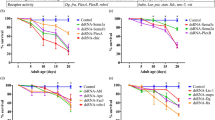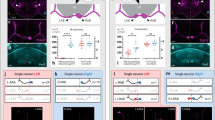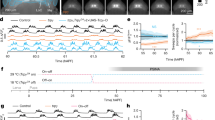Abstract
DURING development, neurons are capable of selecting specific pathways that lead them to their appropriate target areas. A variety of molecular mechanisms are thought to be involved in pathway recognition, including cell adhesion1, repulsion2,3and chemotropism4. However, apart from a few genes whose involvement has been shown genetically5-8, the mechanisms underlying neuronal pathway selection are largely unknown. Here we report the isolation of the Drosophila derailed (drl) gene, which encodes a novel member of the receptor protein-tyrosine kinase family. Using a newly developed axon-targeted reporter gene9 we find that drl is expressed by a small subset of embryonic interneurons whose growth cones choose common pathways during development. Indrl mutant embryos these neurons fail to make the correct pathway choices. Our results provide evidence for receptor protein-tyrosine kinase involvement in key aspects of neuronal pathway recognition.
This is a preview of subscription content, access via your institution
Access options
Subscribe to this journal
Receive 51 print issues and online access
$199.00 per year
only $3.90 per issue
Buy this article
- Purchase on Springer Link
- Instant access to full article PDF
Prices may be subject to local taxes which are calculated during checkout
Similar content being viewed by others
References
Rutishauser, U. Curr. Opin. Neurobiol. 3, 709–715 (1993).
Luo, Y., Raible, D. & Raper, J. A. Cell 75, 217–227 (1993).
Nose, A., Takeichi, M. & Goodman, C. S. Neuron 13, 525–539 (1994).
Kennedy, T. E., Serafini, T., de la Torre, J. R. & Tessier-Lavigne, M. Cell 78, 425–435 (1994).
Elkins, T., Zinn, K., McAllister, L., Hoffmann, F. M. & Goodman, C. S. Cell 60, 565–575 (1990).
Leung-Hagesteijn, C. et al. Cell 71, 289–299 (1992).
Lin, D. M., Fetter, R. D., Kopczynski, C., Grenningloh, G. & Goodman, C. S. Neuron 13, 1055–1069 (1994).
Thomas, J. B. & Wyman, R. J. Nature 298, 650–651 (1982).
Callahan, C. A. & Thomas, J. B. Proc. natn. Acad. Sci. U.S.A. 91, 5972–5976 (1994).
O'Kane, C. J. & Gehring, W. J. Proc. natn. Acad. Sci. U.S.A. 84, 9123–9127 (1987).
Smith, H. K. & O'Kane, C. J. Wilhelm Roux Arch. dev. Biol. 200, 306–311 (1991).
Bier, E. et al. Genes Dev. 3, 1273–1287 (1989).
Jan, L. Y. & Jan, Y. N. Proc. natn. Acad. Sci. U.S.A. 79, 2700–2704 (1982).
Van Vactor, D., Sink, H., Fambrough, D., Tsoo, R. & Goodman, C. S. Cell 73, 1155–1164 (1993).
Nose, A., Mahajan, V. B. & Goodman, C. S. Cell 70, 553–567 (1992).
Doe, C. Q. & Goodman, C. S. in The Development of Drosophila melanogaster (eds Bate, M. & Martinez Arias. A.) 1131–1206 (Cold Spring Harbor Lab., Cold Spring Harbor, 1993).
Bourgouin, C., Lundgren, S. E. & Thomas, J. B. Neuron 9, 549–561 (1992).
Gilbert, D., Hirsh, J. & Wright, T. R. F. Genetics 106, 679–694 (1984).
Wright, T. R. F. et al. Chromosoma 83, 45–58 (1981).
Gay, P. & Contamine, D. Molec. gen. Genet. 239, 361–370 (1993).
van der Geer, P., Hunter, T. & Lindberg, R. A. A. Rev. Cell Biol. 10, 251–337 (1994).
Hafen, E., Basler, K., Edstroem, J.-E. & Rubin, G. M. Science 236, 55–63 (1987).
Aroian, R. V., Koga, M., Mendel, J. E., Ohshima, Y. & Sternberg, P. W. Nature 348, 693–698 (1990).
Klambt, C., Glazer, L. & Shilo, B.-Z. Genes Dev. 6, 1668–1678 (1992).
Chao, M. V. Neuron 9, 583–593 (1992).
Hovens, C. M. et al. Proc. natn. Acad. Sci. U.S.A. 89, 11818–11822 (1992).
Maminta, M. L. D. et al. Biochem. biophys. Res. Commun. 189, 1077–1083 (1992).
Stacker, S. A. et al. Oncogene 8, 1347–1356 (1993).
Jiang, J., Kosman, D., Ip, Y. T. & Levine, M. Genes Dev. 5, 1881–1891 (1991).
Hubbard, S. R., Wei, L., Ellis, L. & Hendrickson, W. A. Nature 372, 746–754 (1994).
Author information
Authors and Affiliations
Rights and permissions
About this article
Cite this article
Callahan, C., Muralidhar, M., Lundgren, S. et al. Control of neuronal pathway selection by a Drosophila receptor protein-tyrosine kinase family member. Nature 376, 171–174 (1995). https://doi.org/10.1038/376171a0
Received:
Accepted:
Issue Date:
DOI: https://doi.org/10.1038/376171a0
This article is cited by
-
The non-canonical Wnt receptor Ryk regulates hematopoietic stem cell repopulation in part by controlling proliferation and apoptosis
Cell Death & Disease (2016)
-
Wnt Signaling in Vertebrate Neural Development and Function
Journal of Neuroimmune Pharmacology (2012)
-
Drosophilaas a genetic and cellular model for studies on axonal growth
Neural Development (2007)
-
In vivo evidence for a regulatory role of the kinase activity of the linotte/derailed receptor tyrosine kinase, a Drosophila Ryk ortholog
Development Genes and Evolution (2005)
Comments
By submitting a comment you agree to abide by our Terms and Community Guidelines. If you find something abusive or that does not comply with our terms or guidelines please flag it as inappropriate.



